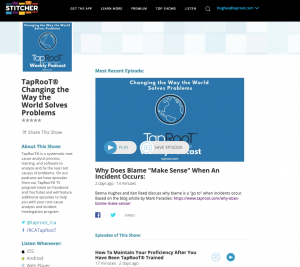Join Benna Hughes & Mark Paradies for a Pre-Summit Preview: A TapRooT® TV video premiere

Join Benna Hughes and Mark Paradies for a TapRooT® TV video premiere: A Pre-Summit Preview
• • •
Benna Hughes and Mark Paradies will provide you a preview of the Pre-Summit courses, March 9-10, to be featured in the upcoming 2020 Global TapRooT® Summit, March 11-13, at Horseshoe Bay Resort, near Austin, Texas.
First, enjoy the video. Next, read on to learn what the 2020 Global TapRooT® Summit has to offer you and your organization. Finally, double-check to ensure you are using the discounts and that you are registered to attend.
Reap the benefits of learning through advanced Pre-Summit courses, conveniently offered March 9-10, 2020
• • •
For those of us focused on performance improvement, the Pre-Summit courses for the 2020 Global TapRooT® Summit present opportunities akin to the most tempting box of chocolates you can imagine. You’ll understand the analogy when you see the topics for the 2020 Pre-Summit courses—offered March 9-10, the first two days of Summit Week—as each Pre-Summit course has its unique appeal and attributes for how it can help your performance and that of your organization.
How to tune in to TapRooT® TV
We premiere new TapRooT® videos on Wednesdays, a little after noon EST, first on Facebook (click here to watch on Facebook), and then on YouTube (click here to watch on YouTube) about an hour later.
NOTE: While you’re tuning in, be sure to:
- Tap the “Follow” button on our videos so you will receive notifications
- Subscribe to our YouTube channel
- Turn on the notification bell to get an alert every time we upload a new video
Did you know that you can listen to TapRooT® on the go via our Podcast channel?
Find our channel on iTunes and Stitcher.

Take a look at the Pre-Summit course topics and see if you don’t agree

- TapRooT® Root Cause Analysis Training
- Equifactor® Equipment Troubleshooting and Root Cause Analysis
- TapRooT® Analyzing and Fixing Safety Culture Issues
- Risk Management – Best Practices & ROBT Risk & Opportunity Based Thinking
- TapRooT® Software Implementation & Application
- Using “What if” and TapRooT® for Hazard Assessment
- TapRooT® Evidence Collection and Interviewing Techniques to Sharpen Investigation Skills
- Stopping Human Error
- Best Practices in Mistake Proofing & Effective Corrective Actions
- TapRooT® Root Cause Analysis for Patient Safety Improvement
To help you with your decision, consider that many of the 2020 Pre-Summit topics are a one-time occurrence. Each year, Mark Paradies, President of System Improvements, picks which Pre-Summit course topics will be offered during Summit Week. He chooses the topics to help all levels of TapRooT® Users learn even more about root cause analysis and performance improvement—lessons that go beyond the standard 2-Day and 5-Day TapRooT® courses.

Which Pre-Summit course is right for you?
The short answer is, Choose the course that will provide the knowledge you need to help your facility reach the next level– whether it’s improving safety, quality, patient safety, root cause analysis, trending, equipment reliability, or something else.
For a more studied approach, let’s consider exactly which one of the 2020 Pre-Summit courses is the best fit for your needs. We’ll go through each course and, hopefully, you will recognize the course description that is a lock for your purposes.
-
TapRooT® Root Cause Analysis Training
The 2-Day TapRooT® Root Cause Analysis Course focuses on the essential TapRooT® techniques needed to investigate a precursor incident. The 5-Step investigation process simplifies TapRooT® to make the investigation efficient yet effective. The training focuses on understanding what happened, identifying Causal Factors, analyzing the Causal Factors using the Root Cause Tree®, and developing effective fixes using the Corrective Action Helper® Module.
REGISTER for the TAPROOT® ROOT CAUSE ANALYSIS TRAINING *and* the 2020 Global TapRooT® Summit (March 9 – 13, 2020). REGISTER for this 2-day course only (March 9 – 10, 2020).
-
Equifactor® Equipment Troubleshooting and Root Cause Analysis
Do you have repeat equipment failures? The Equifactor® and TapRooT® Techniques are designed to help you troubleshoot equipment problems and get the information you need to find and fix the root causes of equipment related failures. The Equifactor® Techniques are based on the work of noted equipment reliability expert Heinz Bloch. The tools can be used by maintenance personnel, equipment reliability specialists, maintenance managers, or investigators who don’t have an extensive understanding of equipment engineering.
In two days, you will learn how to use Equifactor® to troubleshoot equipment issues and find out what is leading to failures. Then you will learn to use the TapRooT® System to organize the information you collect, identify the Causal Factors of the failure, and find the fixable root causes of the failure. Finally, you will learn to develop effective fixes to stop future equipment failures.
REGISTER for the EQUIFACTOR® EQUIPMENT TROUBLESHOOTING AND ROOT CAUSE ANALYSIS *and* the 2020 Global TapRooT® Summit (March 9 – 13, 2020).
-
TapRooT® Analyzing and Fixing Safety Culture Issues
This course includes:
- A clear definition of safety culture.
- An overview of various safety culture models.
- An organizational culture survey from Human Synergistics International designed to identify your current culture.
- Why it is good business to improve the safety culture.
- The relationship between incidents and safety culture.
- The importance of strong safety leadership. What some organizations are doing to strengthen their safety culture.
- What “puzzle pieces” you need to put in place to improve your safety culture.
REGISTER for TAPROOT® ANALYZING AND FIXING SAFETY CULTURE ISSUES *and* the 2020 Global TapRooT® Summit (March 9 – 13, 2020).
-
Risk Management – Best Practices & ROBT Risk & Opportunity Based Thinking
In all your HSEQ risk domains and management Systems, are you frustrated that the outcomes of your current risk assessments performed in your organization lack consistency, confidence, reliability, and accuracy?
Do you & your facilitators and participants of the risk assessments have the knowledge & skills to use the most effective RA methods and tools?
Risk & Opportunity Based Thinking (ROBT) & Risk Assessments (RA) are now recognized by new versions of ISO 31000 / ISO 45001 / ANSI Z10 / ISO 14001 / ISO 9001 / ANSI Z590.3 as definitely needed in each and every risk-informed, decision-making process.
ROBT and RA need to be applied in all aspects of your business without being confused and undermined by subjective beliefs, biases, and risk perceptions.
The course has been continually improved. It still covers the core best practices that have made facilitation and participation in risk assessments as accurate and reliable as possible.
REGISTER for RISK MANAGEMENT – BEST PRACTICES & ROBT RISK & OPPORTUNITY -BASED THINKING *and* the 2020 Global TapRooT® Summit (March 9 – 13, 2020).
-
TapRooT® Software Implementation and Application
To get the most from your TapRooT® VI Software, you need to learn how to:
- Create your own Custom Tabs, fields and pick lists.
- Design and build your own reports.
- Select Global preferences for your company, including Language options.
- Select SnapCharT® preferences for yourself.
- Use Optional investigation techniques.
Dan Verlinde, Director of Information Technology and Software Development and Angie Comer, Software Project Manager, will teach an intensive review of the TapRooT® VI Software. Whether you are a System Administrator or a TapRooT® User, you will learn all the capabilities built into this amazing software. Don’t get just 10-20% of your software investment. Learn the full power of your TapRooT® Software!
REGISTER for TAPROOT® SOFTWARE IMPLEMENTATION AND APPLICATION *and* the 2020 Global TapRooT® Summit (March 9 – 13, 2020).
-
Using “What if” and TapRooT® for Hazard Assessment
The 2-Day What-If & TapRooT® Hazard course is a process hazard analysis course incorporating many of the methodologies used during an incident investigation. The SnapCharT® will be used to map out actions and all the conditions necessary for successful management of change. Using process and instrument drawings, the class will practice using Safeguard analysis to generate the type of thought-provoking questions essential to facilitate a What-If team analysis.
The same process used to develop action items following an incident investigation will be proactively applied. Using the Root Cause Tree® and Root Cause Tree® Dictionary to analyze significant issues, the Corrective Action Helper® Guide will aid in creating an action plan to address potential problems associated with a change in process design.
During the 2-Day What-If course, you will practice the communication skills needed to facilitate a team meeting effectively. The What-If methodology is well-suited for identifying potential hazards when managing change. Incorporating many of the TapRooT® skills proactively in the What-If analysis will keep your incident investigators ready when they need to lead an investigation.
REGISTER for USING “WHAT IF” AND TAPROOT® FOR HAZARD ASSESSMENT *and* the 2020 Global TapRooT® Summit (March 9 – 13, 2020).
-
TapRooT® Evidence Collection and Interviewing Techniques to Sharpen Investigation Skills
There is so much to remember during evidence collection … and so much to lose if you are not prepared.
- Ever have trouble completing a sequence of events in a SnapCharT® because you lacked pieces of information?
- How can you be certain what to collect?
- How do you help witnesses to an incident remember important facts with better accuracy during an investigative interview?
- What is an effective sequential structure for conducting an investigation interview?
- What is the best way to handle the challenges of preservation and contamination of evidence?
Why is Evidence Collection and Investigation Interview Training Important?
Solid evidence collection methods are critical to finding the real root causes of incidents. Evidence collection supports the investigation with facts (not opinions), and creates a clear sequence of events. Sharpen your skills by attending training and practicing skills through hands-on exercises.
Day 1 of this 2-day course is focused on preplanning, emergency response and evidence collection procedures (physical evidence, recordings, and paper evidence). Overviews of the TapRooT® investigation processes are presented to demonstrate how evidence collection fits into the TapRooT® System. It is essential to build an accurate sequence of events in an investigation, so SnapCharT® basics are also reviewed on Day 1 for those who have not taken TapRooT® Root Cause Analysis Training or those who need a refresher.
Day 2 is all about collecting people evidence. Most investigators have not had formal training on how to conduct investigative interviews, yet people evidence is crucial to solving problems; therefore, the TapRooT® 12-Step Interviewing Process is presented in-depth and practiced. This day includes how to use TapRooT® interviewing techniques like Change Analysis, and how to use the Root Cause Tree and Dictionary, essential tools for evidence collection. Finally, attendees learn how to “hear” what’s not said during an investigation interview by decoding nonverbal cues.
REGISTER for TAPROOT® EVIDENCE COLLECTION AND INTERVIEWING TECHNIQUES TO SHARPEN INVESTIGATION SKILLs *and* the 2020 Global TapRooT® Summit (March 9 – 13, 2020).
-
Stopping Human Error
Joel Haight, human factors expert, will teach basic and advanced knowledge of human error prevention in this 2-day course.
Blame is common after an accident. After all, a human made a mistake. It is their fault! Or is it? Sometimes errors are designed into the system. And you can find and fix these system causes of human error before the accident happens.
The goal of this course is to teach you to understand human error, how humans operate….what are our capacities, constraints, and needs so that we can maximize human performance and minimize human errors.
Would you like to understand human errors and how to analyze, predict, and categorize them? Course participants will learn to minimize errors and the resulting impact in their own facilities with tools that can be used in conjunction with the TapRooT® System and incorporated into your corrective actions.
There will be hands-on exercises, including an analysis of an unsolved example (error case) that you bring from your facility. We’ll try to dissect and solve it during the course
REGISTER for STOPPING HUMAN ERROR *and* the 2020 Global TapRooT® Summit (March 9 – 13, 2020).
-
Best Practices in Mistake Proofing & Effective Corrective Actions
Zero error and six sigma levels of quality cannot be achieved by simply reminding people to be careful, watching training videos, or reviewing procedures once a year. How do restaurant, energy, and aviation employees achieve very low error rates on a consistent basis, while others who do less mistake-prone work make significantly more errors each day? What approaches are used to obtain higher levels of policy and procedure compliance? How do the best organizations use work process and tool design to drive personal accountability on the job?
When incidents, recalls, sentinel events, production outages, customer complaints, and daily errors do happen, most problem-solving efforts typically produce a weak mix of corrective actions. In other words, the fixes often fail to prevent the errors that contributed to the problem from happening again. In turn, the same problems pop up again, often across multiple locations and workgroups. Risk levels fail to be reduced, and process failures and costs remain high. Additionally, the bulk of the investigative effort was wasted.
This workshop explores the common types of work process and tool design flaws that contribute to human error, including fixes that fail. It also gives you a coach and a practice field for learning to write more effective and sustainable corrective and preventive actions. Finally, this workshop gives you many best practices you can use to more effectively, and proactively, ‘mistake-proof’ your workplace by fixing key work process and tool design flaws.
REGISTER for BEST PRACTICES IN MISTAKE PROOFING & EFFECTIVE CORRECTIVE ACTIONS *and* the 2020 Global TapRooT® Summit (March 9 – 13, 2020).
-
TapRooT® Root Cause Analysis for Patient Safety Improvement
Healthcare organizations, including Emory University Hospitals and the U.S. Military Health System, have taken advantage of the knowledge gained by the implementation of the TapRooT Root Cause Analysis methodology, evidence collection tools, and software capabilities. The TapRooT 2-Day Patient Safety Course focuses on how to stop needless deaths and improve hospital financials by leveraging TapRooT to reduce risk, improve the quality of care, create a just culture, reduce financial penalties for bad outcomes, reduce litigation costs resulting from mistakes, and increase efficiencies in operations while protecting patients and staff.
REGISTER for PATIENT SAFETY *and* the 2020 Global TapRooT® Summit (March 9 – 13, 2020).
How to register for the Pre-Summit course of your choice?
Now that we’ve explored each of the 2020 Pre-Summit courses, you should be able to make an informed choice about which course best suits your needs. To register for your choice for a Pre-Summit course, scroll up to the course description of your choice in this blog post. Under the description, you will find two registration links. Don’t miss the important note below about the discount.

AN IMPORTANT NOTE: IF YOU REGISTER FOR YOUR PRE-SUMMIT COURSE AND THE SUMMIT SIMULTANEOUSLY, YOU GET A $200 DISCOUNT!

The 2020 Global TapRooT® Summit, now in its 32nd year, will be held at the Horseshoe Bay Resort, near Austin, Texas, March 9-13, 2020. Hear and learn from well-known, incredible speakers and outstanding keynote speakers; choose from multiple tracks designed to improve performance; adopt root cause analysis best practices across industries and professions, and gain the career advantage that Summit attendance has proven to be. Did we mention the networking that draws people together and sparks engagement? And, the not-to-be-missed reception.
NOTE: Summit participants can get CEU credits for both the Summit and the Pre-Summit courses.
To learn more about the 2020 Global TapRooT® Summit, check out the Summit brochure, the schedule, and the FAQ.
See you at Horseshoe Bay!



